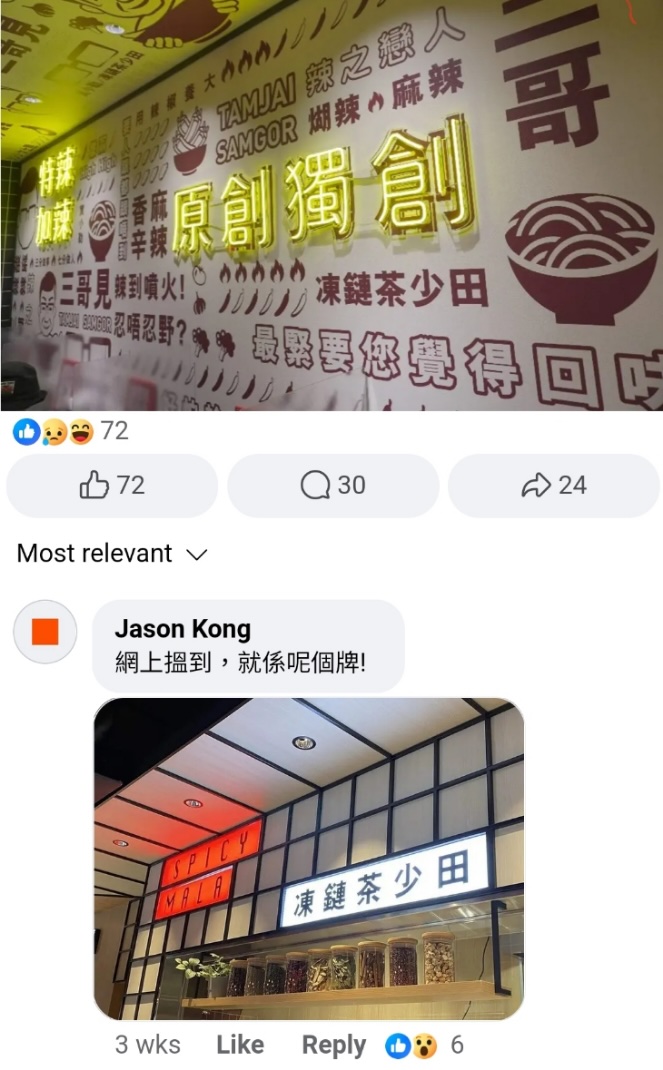The perception and construction of Hong Kong identity via the quotation of non-standard Cantonese
« previous post | next post »
Assertively spicy and conspicuously Cantonese
That's almost a contradiction in terms, because Hong Kongers are not very big on spicy food and they generally are not very good at cooking it either.
Photographs of walls in a popular chain of special Yunnan style spicy noodles in Hong Kong:
(Facebook)
In the second photograph where it has Latin letters on a red background, at first I thought it said "SPICY MAIR". The second word is actually "málà 麻辣", which means "numbing and spicy", a quintessential Sichuanese combination of flavors.
Also prominent (on the wall with yellow neon lights) is TamJai SamGor ("Three Tam Brothers' Noodles"), which is how the restaurant is known to most people.
Perhaps the most famous tagline associated with the TamJai SamGor ("Three Tam Brothers' Noodles") restaurants is "dung3 lin2 caa4 siu2 tin4 凍鏈茶少田". It looks like it means "frozen chain tea few fields". I've shown it to many native speakers of Mandarin, and even some individuals who have exposure to and knowledge of Modern Standard Cantonese (MSC) can't get it.
That's Tamjaiese (taam4 zai2 waa6 譚仔話) for MSC dung3 ling4 caa4 zau2 tim4 凍檸茶走甜 ("iced lemon tea [without adding sugar because it's already] on the sweet side"). The phrase is searchable on Google.
What is Tamjaiese? Aside from the delicious, inexpensive food served at TamJai SamGor ("Three Tam Brothers' Noodles"), one of the things about it that brings in the crowds is the Nonstandard Cantonese (NSC) spoken by the waitpersons (many of whom are new immigrants from Guangzhou) that customers find delectable, and are even disappointed when the waitpersons speak MSC, as documented in these videos:
https://www.youtube.com/watch?
https://www.youtube.com/watch?
https://www.youtube.com/watch?
At the beginning of the last video, the waiter repeats the customer’s order in standard Cantonese, but the customer does not think the waiter understands. Then, a Tamjaiese speaking waitress uses NSC Tamjaiese to repeat the order, and the customer is satisfied. After this, the male waiter starts to practice NSC Tamjaiese.
Tam Jai Noodle is so popular that it even has its own quite good Wikipedia entry in English.
Here's a good description of Tamjaiese on a Japanese blog.
Here's an advertisement related to NSC Tamjaiese English. In this ad, gwat1 mo1 ling4 骨魔鈴 (looks like it means "bone demon bell") actually stands for "good morning". Sorry, I don't know the NSC Tamjaiese, so I just gave the MSC pronunciation.

Selected readings
- "A Less Grand Chinglish" (5/30/06)
- "The mystery of 'mouthfeel'" (11/2/16)
- "Wonton in Zanthoxylum schinifolium etzucc sauce" (5/6/15) — "málà 麻辣", which means "numbing and spicy"
- "Prickly ash revisited", JSBlog – Journal of a Southern Bookreader (5/7/15)
- "Taishan and Chinatown" (2/5/22)
[thanks to shaing tai, Zeyao Wu, Zhaofei Chen, and Xinyi Ye]

Isoraķatheð Zorethan said,
June 2, 2024 @ 8:38 am
If I remember right, the "sam" in "Tamjai Samgor" is ordinal, not cardinal; there is another chain just called 譚仔 which this one is a spin-off of. Originally, the 3rd and 6th children of the Tam family created the 譚仔 restaurant chain; then they had a falling out and the former started his own chain with a few changes.
Vampyricon said,
June 19, 2024 @ 6:18 pm
Seconding that 三 is probably ordinal. N哥 usually means the N-th brother